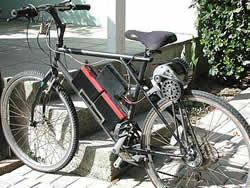Have you ever thought of riding a bike to work whilst stuck in traffic gridlock?
Many have, often deciding against the idea because it seemed like too much work or the travel distance was too great. Well, this may just be the solution you were looking for.
In our quest to reduce global pollution many inspired inventors, scientists and ordinary people have come up with some amazing and innovative solutions to some of modern life's everyday requirements. From apartment worm composting to building roads from pop bottles, we are really "stepping up to the plate" and creating functional alternatives to our polluting ways.
A ray of sun

For Mike Hills of New Ipswich, USA, designing a "green" means of transportation for the average urban commuter is his way of peddling a greener future. Initially intending to capitalize on what he sees as a niche market, Hills is encouraged by the fact that his product has relatively little environmental impact and has the option of producing no greenhouse gas emissions once assembled.
"There is a market to be filled here. It's not something a giant corporate automaker can take on because they think they can't generate enough sales and they're not even sure that there is a market. We, however,can survive on a small production operation… then of course, there's the fate of the world as dictated by the state of the environment, but that it is improving as a result of our product is a happy fringe benefit." says Hills.
Using modern technology such as electric motors and photovoltaic cells (solar panels), Hills and his 4-member team at Solar Bicycle have been transforming the ordinary street bike into a vehicle capable of transporting its rider for up to 100 miles at 30 miles per hour - without a single turn of the crankshaft!
On a cloudy day, however, the distance is reduced to 20 miles without pedaling.
How it works
The Solar Bike's design incorporates the front and rear fenders into a small array of solar panels that transfer energy to 2, 12 volt deep cell batteries located on the bike's frame just below the cross bar. From there, a small electric motor above the rear wheel powers the bike. The whole system is on a continuous feedback loop, enabling the bike to partially recharge while in use thus extending the bike's range. A simple throttle located on the handlebars gives you variable speed control.
The rider can switch from pedal power to solar power easily, and when not in use, the solar panels continue to recharge thebatteries. The motor's maximum 4-horsepower capabilities aid this 80-pound vehicle in speedy hill ascents.
Maintenance requirements are the same as an ordinary street bike, with the exception of having to wipe the solar panels at -least once a month and changing the 97% recyclable batteries once every 3-4 years.
Still under development, however, is a "quick release" system to easily remove the solar power units from the bike for security purposes, or for recharging the system if the bicycle is typically stored indoors or other places where it does not have access to direct sunlight.
The future looks greener
Scheduled for release onto the market in January of 2004, this reasonably priced ($1600.00 US) Solar Bicycle will be the world's only commercially available solar powered vehicle according to Hills.
When asked why his innovation is worth waiting for, Hills replied, "It's going to be a cheap alternative for the commuter. Most people, on their drive to work, go less than 30 miles. The range and speed of the Solar Bicycle is perfect for such a task. It's cleaner and you never have to buy gas or change the oil."
Interest is high even if presales are low. However, Hills is confident his product, which is generating sparks with entrepreneurs looking to market it in USA and Europe, will do well in the long term.
Like most start-up entrepreneurs, Hills and his team are working at reduced salaries and doing all the assembly themselves, yet are planning for a slow but steady increase in output. "We expect to sell approximately 10 per month… which will provide enough capital to pay everyone acceptable salaries and turn the business a marginal profit." says Hills. " We will find dealers to sell our bike for us and expect sellers of ATV's, motorcycles and scooters would be interested."
How far we have come
It may have all started with Karl Von Drias' "Running Machine"(aka Hobby Horse) in 1818, but man's love of the two-wheeler has since taken this relatively simple feat of engineering more than "one step ahead". Touted by some as one of the most energy-efficient means of transportation in existence, modern bicycles are widely varied and capable of many different performance requirements.
When Mr. John Boyd Dunlop re-invented the pneumatic rubber tire in the late 1800s, which for the first time ever allowed man to outdistance a horse in a single day's ride, he could not have imagined how far we would actually go with bicycle technology. Perhaps, like Drias and Dunlop, Mike Hills and his team will play a significant role in the continued evolution of transportation.




0 komentar:
Posting Komentar